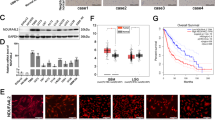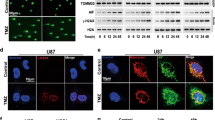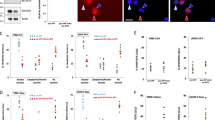Abstract
The expression of inhibitor of apoptosis (IAP) family members contributes to the resistance of human cancers to apoptosis induced by radiotherapy and chemotherapy. We report that the infection of malignant glioma cells and several other tumor cell lines with adenoviruses encoding antisense RNA to X-linked IAP (XIAP) depletes endogenous XIAP levels and promotes global caspase activation and apoptosis. In contrast, non-neoplastic SV-FHAS human astrocytes and other non-neoplastic cells express XIAP at very low levels and resist these effects of adenovirus-expressing XIAP antisense RNA (Ad-XIAP-as). Caspase inhibitors such as z-Val-Ala-DL-Asp(OMe)-fluoromethylketone (zVAD-fmk) delay caspase processing and XIAP depletion, suggesting that XIAP depletion results both from antisense-mediated interference with protein synthesis and proteolytic cleavage by activated caspases. However, zVAD-fmk neither prevents nor delays cell death, indicating a caspase-independent pathway to cell death triggered by IAP depletion. Similarly, B-cell lymphoma-XL (BCL-XL) inhibits caspase activity, but fails to rescue from apoptosis. Loss of p65/nuclear factor-κB (NF-κB) protein and NF-κB activity is an early event triggered by Ad-XIAP-as and probably involved in Ad-XIAP-as-induced apoptosis. Finally, Ad-XIAP-as gene therapy induces cell death in intracranial glioma xenografts, prolongs survival in nude mice and may reduce tumorigenicity in synergy with Apo2L/TNF-related apoptosis-inducing ligand (TRAIL) in vivo. Altogether, these data define a powerful survival function for XIAP and reinforce its possible role as a therapeutic target in human glioma cells.
This is a preview of subscription content, access via your institution
Access options
Subscribe to this journal
Receive 12 print issues and online access
$259.00 per year
only $21.58 per issue
Buy this article
- Purchase on Springer Link
- Instant access to full article PDF
Prices may be subject to local taxes which are calculated during checkout









Similar content being viewed by others
References
Liston P, Fong WG, Korneluk RG . The inhibitors of apoptosis: there is more to life than Bcl2. Oncogene 2003; 22: 8568–8580.
Clem RJ, Miller LK . Control of programmed cell death by the baculovirus genes p35 and iap. Mol Cell Biol 1994; 14: 5212–5222.
Liston P, Roy N, Tamai K, Lefebvre C, Baird S, Cherton-Horvat G et al. Suppression of apoptosis in mammalian cells by NAIP and a related family of IAP genes. Nature 1996; 379: 349–353.
Rothe M, Pan MG, Henzel WJ, Ayres TM, Goeddel DV . The TNFR2–TRAF signaling complex contains two novel proteins related to baculoviral inhibitor of apoptosis proteins. Cell 1995; 83: 1243–1252.
Ambrosini G, Adida C, Altieri DC . A novel anti-apoptosis gene, survivin, expressed in cancer and lymphoma. Nat Med 1997; 3: 917–921.
Hauser HP, Bardroff M, Pyrowolakis G, Jentsch S . A giant ubiquitin-conjugating enzyme related to IAP apoptosis inhibitors. J Cell Biol 1998; 141: 1415–1422.
Vucic D, Stennicke HR, Pisabarro MT, Salvesen GS, Dixit VM . ML-IAP, a novel inhibitor of apoptosis that is preferentially expressed in human melanomas. Curr Biol 2000; 10: 1359–1366.
Salvesen GS, Duckett CS . IAP proteins: blocking the road to death's door. Nat Rev Mol Cell Biol 2002; 3: 401–410.
Yang Y, Yu X . Regulation of apoptosis: the ubiquitous way. FASEB J 2003; 17: 790–799.
Wu G, Chai J, Suber TL, Wu JW, Du C, Wang X et al. Structural basis of IAP recognition by Smac/DIABLO. Nature 2000; 408: 1008–1012.
Creagh EM, Murphy BM, Duriez PJ, Duckett CS, Martin SJ . Smac/Diablo antagonizes ubiquitin ligase activity of inhibitor of apoptosis proteins. J Biol Chem 2004; 279: 26906–26914.
Lewis J, Burstein E, Reffey SB, Bratton SB, Roberts AB, Duckett CS . Uncoupling of the signaling and caspase-inhibitory properties of X-linked inhibitor of apoptosis. J Biol Chem 2004; 279: 9023–9029.
Karin M . The beginning of the end: IkappaB kinase (IKK) and NF-kappaB activation. J Biol Chem 1999; 274: 27339–27342.
Levkau B, Garton KJ, Ferri N, Kloke K, Nofer JR, Baba HA et al. xIAP induces cell-cycle arrest and activates nuclear factor-kappaB : new survival pathways disabled by caspase-mediated cleavage during apoptosis of human endothelial cells. Circ Res 2001; 88: 282–290.
Yamaguchi K, Nagai S, Ninomiya-Tsuji J, Nishita M, Tamai K, Irie K et al. XIAP, a cellular member of the inhibitor of apoptosis protein family, links the receptors to TAB1-TAK1 in the BMP signaling pathway. EMBO J 1999; 18: 179–187.
Birkey Reffey S, Wurthner JU, Parks WT, Roberts AB, Duckett CS . X-linked inhibitor of apoptosis protein functions as a cofactor in transforming growth factor-beta signaling. J Biol Chem 2001; 276: 26542–26549.
Wang Q, Wang X, Evers BM . Induction of cIAP-2 in human colon cancer cells through PKC delta/NF-kappa B. J Biol Chem 2003; 278: 51091–51099.
Tang G, Minemoto Y, Dibling B, Purcell NH, Li Z, Karin M et al. Inhibition of JNK activation through NF-kappaB target genes. Nature 2001; 414: 313–317.
Sanna MG, da Silva Correia J, Ducrey O, Lee J, Nomoto K, Schrantz N et al. IAP suppression of apoptosis involves distinct mechanisms: the TAK1/JNK1 signaling cascade and caspase inhibition. Mol Cell Biol 2002; 22: 1754–1766.
Wagenknecht B, Glaser T, Naumann U, Kugler S, Isenmann S, Bahr M et al. Expression and biological activity of X-linked inhibitor of apoptosis (XIAP) in human malignant glioma. Cell Death Differ 1999; 6: 370–376.
Li L, Thomas RM, Suzuki H, De Brabander JK, Wang X, Harran PG . A small molecule Smac mimic potentiates TRAIL- and TNFalpha-mediated cell death. Science 2004; 305: 1471–1474.
Fulda S, Wick W, Weller M, Debatin KM . Smac agonists sensitize for Apo2L/TRAIL- or anticancer drug-induced apoptosis and induce regression of malignant glioma in vivo. Nat Med 2002; 8: 808–815.
Leaman DW, Chawla-Sarkar M, Vyas K, Reheman M, Tamai K, Toji S et al. Identification of X-linked inhibitor of apoptosis-associated factor-1 as an interferon-stimulated gene that augments TRAIL Apo2L-induced apoptosis. J Biol Chem 2002; 277: 28504–28511.
Bilim V, Kasahara T, Hara N, Takahashi K, Tomita Y . Role of XIAP in the malignant phenotype of transitional cell cancer (TCC) and therapeutic activity of XIAP antisense oligonucleotides against multidrug-resistant TCC in vitro. Int J Cancer 2003; 103: 29–37.
Amantana A, London CA, Iversen PL, Devi GR . X-linked inhibitor of apoptosis protein inhibition induces apoptosis and enhances chemotherapy sensitivity in human prostate cancer cells. Mol Cancer Ther 2004; 3: 699–707.
Inoue H, Shiraki K, Murata K, Sugimoto K, Kawakita T, Yamaguchi Y et al. Adenoviral-mediated transfer of p53 gene enhances TRAIL-induced apoptosis in human hepatocellular carcinoma cells. Int J Mol Med 2004; 14: 271–275.
Glaser T, Weller M . Caspase-dependent chemotherapy-induced death of glioma cells requires mitochondrial cytochrome c release. Biochem Biophys Res Commun 2001; 281: 322–327.
Glaser T, Wagenknecht B, Groscurth P, Krammer PH, Weller M . Death ligand/receptor-independent caspase activation mediates drug-induced cytotoxic cell death in human malignant glioma cells. Oncogene 1999; 18: 5044–5053.
Green DR, Kroemer G . The pathophysiology of mitochondrial cell death. Science 2004; 305: 626–629.
Shikama Y, Yamada M, Miyashita T . Caspase-8 and caspase-10 activate NF-kappaB through RIP, NIK and IKKalpha kinases. Eur J Immunol 2003; 33: 1998–2006.
Bhakar AL, Tannis LL, Zeindler C, Russo MP, Jobin C, Park DS et al. Constitutive nuclear factor-kappa B activity is required for central neuron survival. J Neurosci 2002; 22: 8466–8475.
Lyss G, Knorre A, Schmidt TJ, Pahl HL, Merfort I . The anti-inflammatory sesquiterpene lactone helenalin inhibits the transcription factor NF-kappaB by directly targeting p65. J Biol Chem 1998; 273: 33508–33516.
Martinez-Irujo JJ, Villahermosa ML, Mercapide J, Cabodevilla JF, Santiago E . Analysis of the combined effect of two linear inhibitors on a single enzyme. Biochem J 1998; 329 (Part 3): 689–698.
Sasaki H, Sheng Y, Kotsuji F, Tsang BK . Down-regulation of X-linked inhibitor of apoptosis protein induces apoptosis in chemoresistant human ovarian cancer cells. Cancer Res 2000; 60: 5659–5666.
Hu Y, Cherton-Horvat G, Dragowska V, Baird S, Korneluk RG, Durkin JP et al. Antisense oligonucleotides targeting XIAP induce apoptosis and enhance chemotherapeutic activity against human lung cancer cells in vitro and in vivo. Clin Cancer Res 2003; 9: 2826–2836.
McManus DC, Lefebvre CA, Cherton-Horvat G, St-Jean M, Kandimalla ER, Agrawal S et al. Loss of XIAP protein expression by RNAi and antisense approaches sensitizes cancer cells to functionally diverse chemotherapeutics. Oncogene 2004; 23: 8105–8117.
Glaser T, Wagenknecht B, Weller M . Identification of p21 as a target of cycloheximide-mediated facilitation of CD95-mediated apoptosis in human malignant glioma cells. Oncogene 2001; 20: 4757–4767.
Herrera B, Fernandez M, Benito M, Fabregat I . cIAP-1, but not XIAP, is cleaved by caspases during the apoptosis induced by TGF-beta in fetal rat hepatocytes. FEBS Lett 2002; 520: 93–96.
Esposti MD . The roles of Bid. Apoptosis 2002; 7: 433–440.
Robe PA, Bentires-Alj M, Bonif M, Rogister B, Deprez M, Haddada H et al. In vitro and in vivo activity of the nuclear factor-kappaB inhibitor sulfasalazine in human glioblastomas. Clin Cancer Res 2004; 10: 5595–5603.
Keane RW, Kraydieh S, Lotocki G, Alonso OF, Aldana P, Dietrich WD . Apoptotic and antiapoptotic mechanisms after traumatic brain injury. J Cereb Blood Flow Metab 2001; 21: 1189–1198.
Tanaka H, Yokota H, Jover T, Cappuccio I, Calderone A, Simionescu M et al. Ischemic preconditioning: neuronal survival in the face of caspase-3 activation. J Neurosci 2004; 24: 2750–2759.
Ishigaki S, Liang Y, Yamamoto M, Niwa J, Ando Y, Yoshihara T et al. X-Linked inhibitor of apoptosis protein is involved in mutant SOD1-mediated neuronal degeneration. J Neurochem 2002; 82: 576–584.
Lawrence D, Shahrokh Z, Marsters S, Achilles K, Shih D, Mounho B et al. Differential hepatocyte toxicity of recombinant Apo2L/TRAIL versions. Nat Med 2001; 7: 383–385.
Naumann U, Schmidt F, Wick W, Frank B, Weit S, Gillissen B et al. Adenoviral natural born killer gene therapy for malignant glioma. Hum Gene Ther 2003; 14: 1235–1246.
Rieger J, Wick W, Weller M . Human malignant glioma cells express semaphorins and their receptors, neuropilins and plexins. Glia 2003; 42: 379–389.
Friese MA, Platten M, Lutz SZ, Naumann U, Aulwurm S, Bischof F et al. MICA/NKG2D-mediated immunogene therapy of experimental gliomas. Cancer Res 2003; 63: 8996–9006.
He TC, Zhou S, da Costa LT, Yu J, Kinzler KW, Vogelstein B . A simplified system for generating recombinant adenoviruses. Proc Natl Acad Sci USA 1998; 95: 2509–2514.
Naumann U, Kugler S, Wolburg H, Wick W, Rascher G, Schulz JB et al. Chimeric tumor suppressor 1, a p53-derived chimeric tumor suppressor gene, kills p53 mutant and p53 wild-type glioma cells in synergy with irradiation and CD95 ligand. Cancer Res 2001; 61: 5833–5842.
Weller M, Frei K, Groscurth P, Krammer PH, Yonekawa Y, Fontana A . Anti-Fas/APO-1 antibody-mediated apoptosis of cultured human glioma cells. Induction and modulation of sensitivity by cytokines. J Clin Invest 1994; 94: 954–964.
Weller M, Schmidt C, Roth W, Dichgans J . Chemotherapy of human malignant glioma: prevention of efficacy by dexamethasone? Neurology 1997; 48: 1704–1709.
Li J, Kim JM, Liston P, Li M, Miyazaki T, Mackenzie AE et al. Expression of inhibitor of apoptosis proteins (IAPs) in rat granulosa cells during ovarian follicular development and atresia. Endocrinology 1998; 139: 1321–1328.
Holcik M, Lefebvre CA, Hicks K, Korneluk RG . Cloning and characterization of the rat homologues of the Inhibitor of Apoptosis protein 1, 2, and 3 genes. BMC Genomics 2002; 3: 5.
Acknowledgements
This study was supported by a grant from the Deutsche Krebshilfe to MW and UN.
Author information
Authors and Affiliations
Corresponding author
Rights and permissions
About this article
Cite this article
Naumann, U., Bähr, O., Wolburg, H. et al. Adenoviral expression of XIAP antisense RNA induces apoptosis in glioma cells and suppresses the growth of xenografts in nude mice. Gene Ther 14, 147–161 (2007). https://doi.org/10.1038/sj.gt.3302845
Received:
Revised:
Accepted:
Published:
Issue Date:
DOI: https://doi.org/10.1038/sj.gt.3302845
Keywords
This article is cited by
-
An anthraquinone derivative, emodin sensitizes hepatocellular carcinoma cells to TRAIL induced apoptosis through the induction of death receptors and downregulation of cell survival proteins
Apoptosis (2013)
-
Role of FK506-binding protein 51 in the control of apoptosis of irradiated melanoma cells
Cell Death & Differentiation (2010)
-
Effects of cIAP-1, cIAP-2 and XIAP triple knockdown on prostate cancer cell susceptibility to apoptosis, cell survival and proliferation
Molecular Cancer (2009)
-
Gene therapy as an adjuvant treatment for malignant gliomas: from bench to bedside
Journal of Neuro-Oncology (2009)



